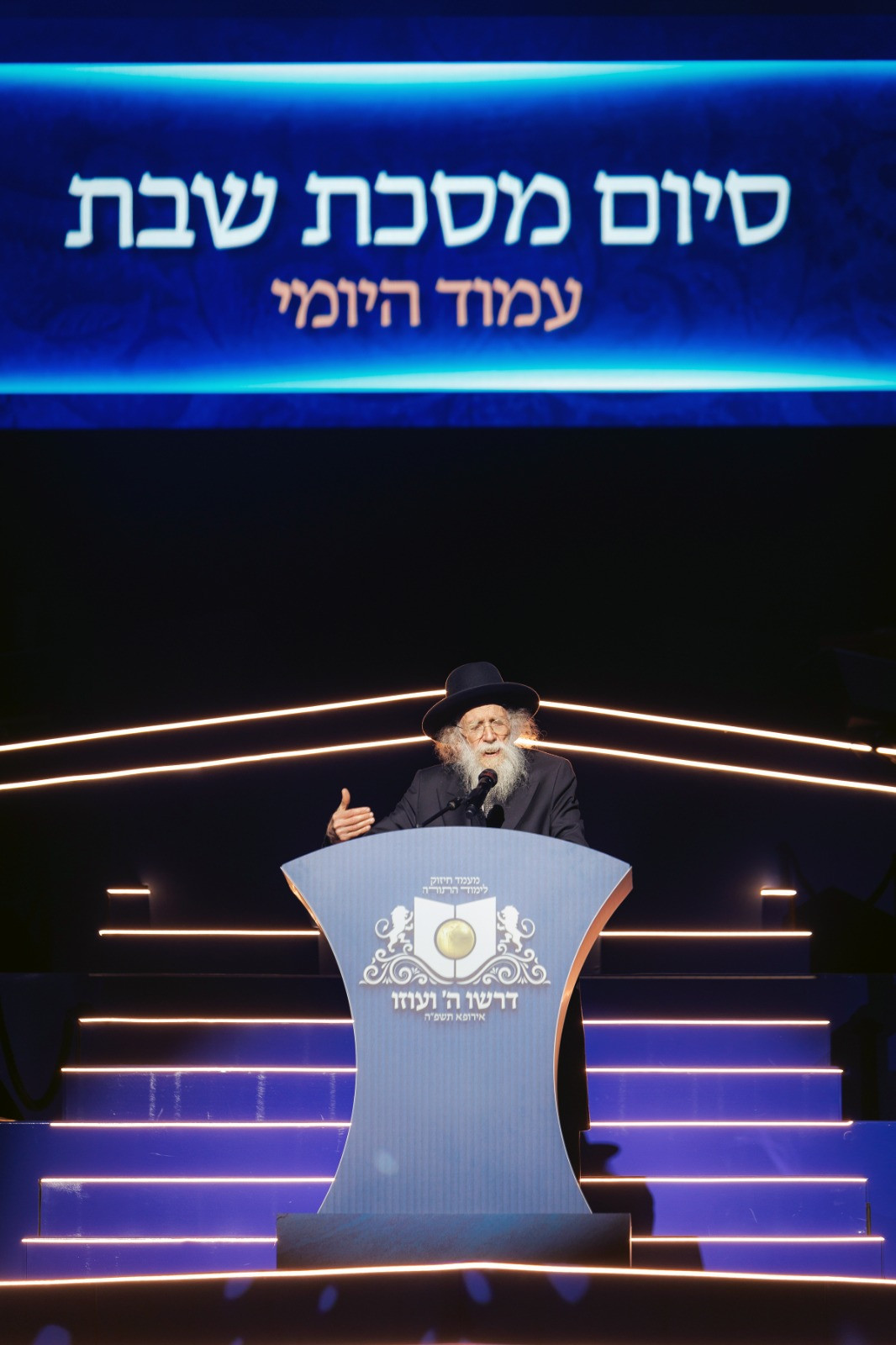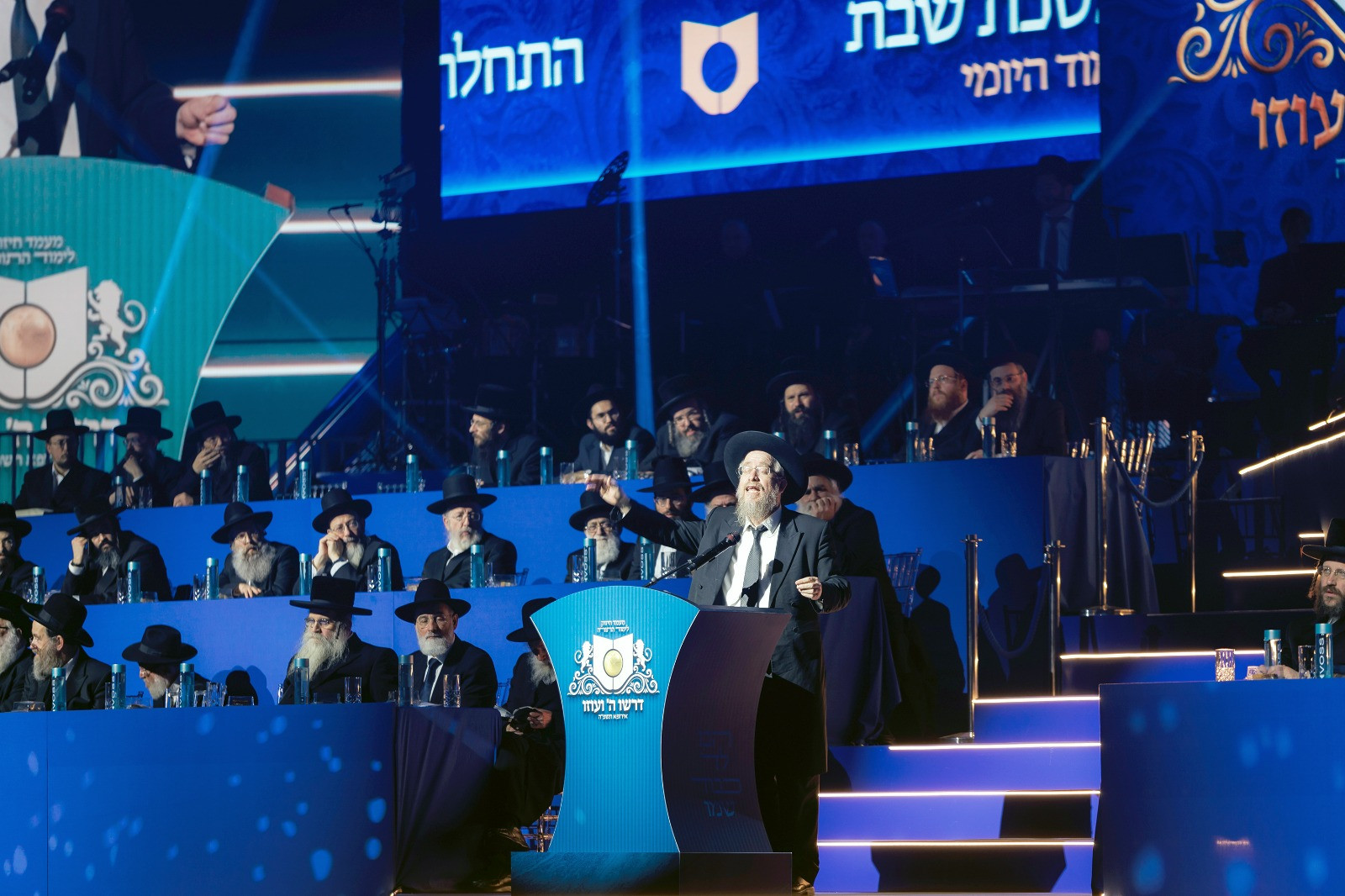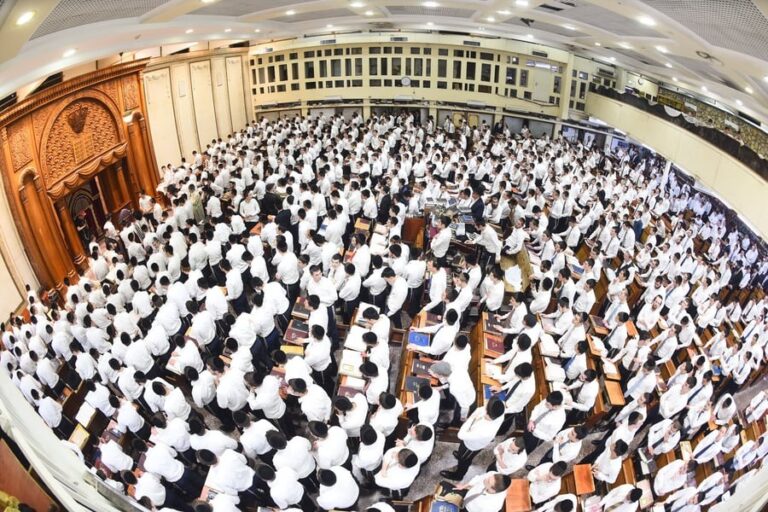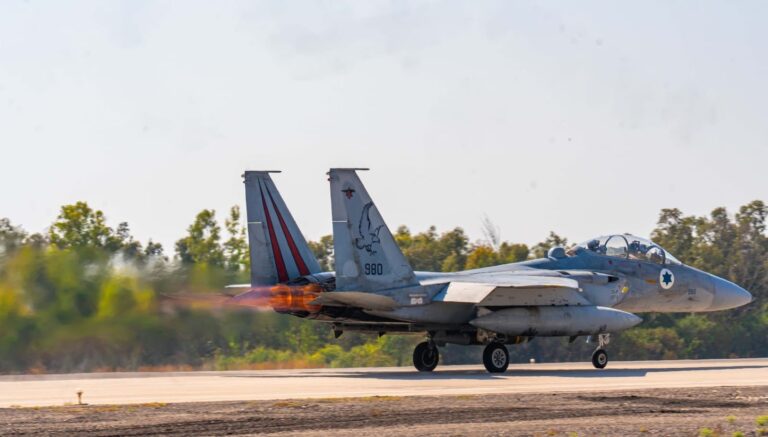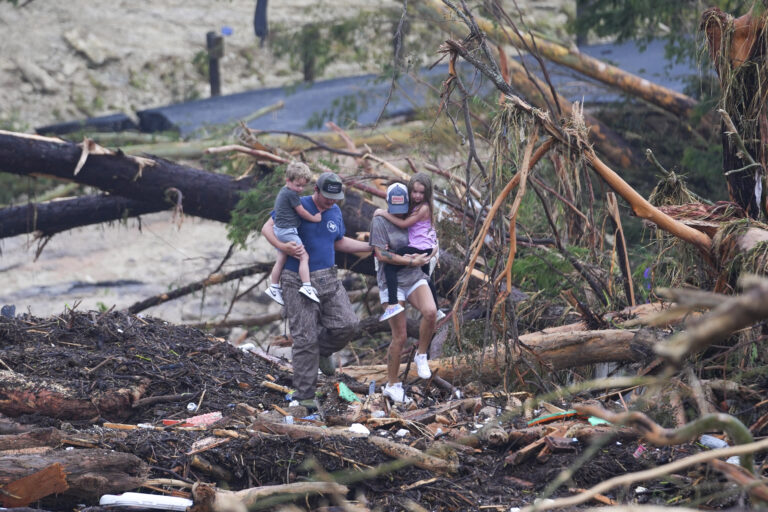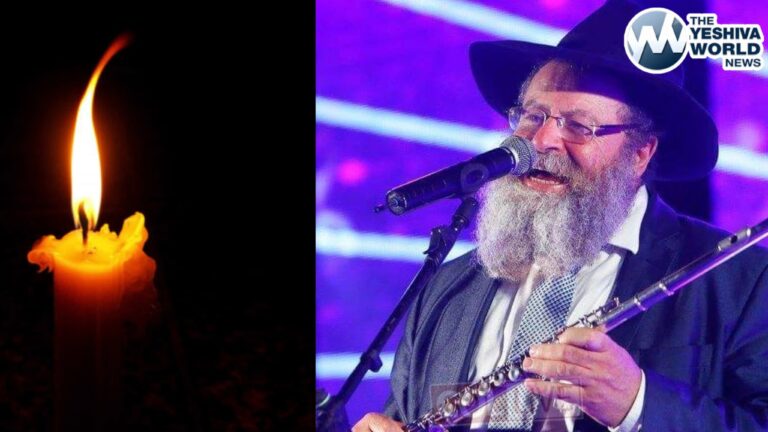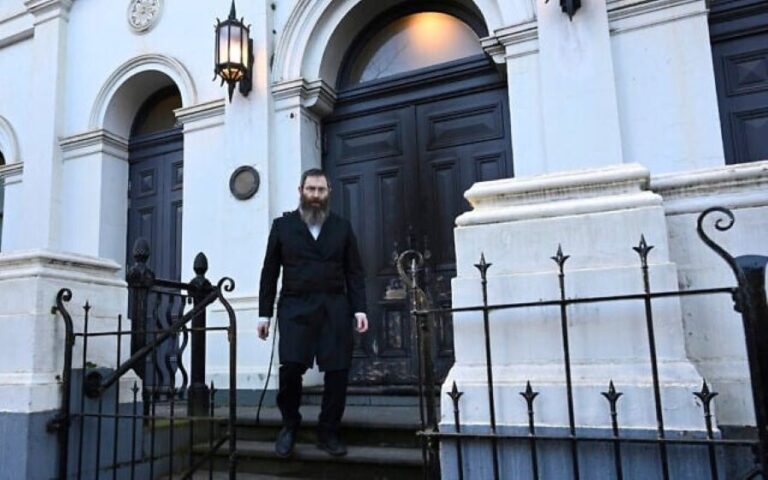By Chaim Gold
“On fire! The London frum community was on fire! There is no other way to describe it. This Dirshu siyum was a milestone, a watershed moment! I don’t think we have ever seen such an outpouring of emotion, chizuk, kabbolas ol and dedication to keviyus ittim l’Torah as we saw at last week’s Dirshu Siyum in London’s Copper Box Arena.” These passionate words of a prominent London talmid chacham, himself a Dirshu maggid shiur, could barely encapsulate the fiery enthusiasm that has overtaken all of England.
There were many sparks throughout the siyum that ignited that fire. One such surreal moment was when the venerated Gaon and Tzaddik Rav Shimon Galei began singing. Yes, singing. Holding the microphone tightly, his eyes raised to the Heavens, the joyous, heartfelt words “Shaarei shomayim pesach” burst from his lips. The massive arena had been quiet, the attendees hanging onto his every word when… suddenly, the dam broke. In an eruption of emotion everyone got to their feet and began singing, “Shaarei shomayim pesach” together with Rav Shimon. Surreal indeed!
What was the background to that moment, that spark of fire that set the tone for the rest of the night?
“What an Eis Ratzon This is! We Can Ask Hashem for Anything!”
Rav Shimon Galei was speaking about how the yetzer hara hates kevius, hates when Yidden are koveiah ittim, and certainly when they begin a program of kevius such as the Amud HaYomi when Yidden are empowered to complete a large masechta like Masechta Shabbos, and then immediately segue into the difficult masechta of Eruvin. When Yidden learn Torah this way with a kevius and accountability it creates a tremendous eis ratzon, an opportune time in Heaven to daven and ask Hashem for anything! There is no greater eis ratzon than when Yidden come to celebrate these Torah accomplishments.
“A siyum masechta is a time when there is a great eis ratzon in shomayim. If this is said about any siyum, how much more so, a siyum being made by thousands! Now is the time for all of us to daven for Klal Yisrael who are undergoing great difficulty and for all our personal tefillos as well.”
“What an eis ratzon this is!” Rav Galei exclaimed. “The Heavens are wide open, the shaarei shomayim are open! We can ask Hashem for whatever we want!
Right then and there, Rav Shimon spontaneously began to sing, “Shaarei shomayim pesach,” a song where we beg Hashem to open the gates of heaven and shower us with bracha from His infinite otzar, treasure house of bracha.
The tangible emotion and feeling of Rav Shimon rippled through the hall, touching the souls of everyone present… and the usually reserved English crowd joined him, raising their voices in song. Soon, everyone was on their feet singing, davening. The emotion reached a crescendo and it was clear to everyone there that they were indeed tapping into a unique eis ratzon. The emotion, the tefillos, the tears that were shed, defy description.
A Transformative Day
The event held at this massive venue in London was deeply emotional because first and foremost it featured addresses from Gedolei Yisrael and was attended by Rabbanim from throughout England and even from Belgium and Switzerland. The simchas haTorah was enhanced by some of Klal Yisrael’s most talented mezamrim including Boruch Levin, Motti Steinmetz, Zanvil Weinberger, Hershy Weinberger, and the Malchus Choir accompanied by the elite symphony orchestra led by R’ Mona Rosenblum.
The drashos and siyum were interspersed with beautiful niggunim as well as a beautiful medley featuring the magnificent songs of the late composer and choir master of the London School of Jewish Song, R’ Yigal Calek that electrified the crowd.
Foremost, however were the powerful words of the Gedolei Yisrael, the Gaonim HaRav Shimon Galei, shlita, HaRav Nissan Kaplan, shlita, Rosh Yeshivas Daas Aharon, HaRav Aharon Schiff, shlita, Rav of the Machzikei Hadas Kehillah of Antwerp, HaRav Dovid Hofstedter shlita, Nasi Dirshu, HaRav Shalom Freidman, shlita, Segan Av Beis Din of the Kedassia Beis Din of London, HaRav Tzvi Elimelech Padwa, shlita, Rav of Agudas Achim, Zurich, HaRav Shimon Spitzer, shlita, well known mashpia and HaRav Yehuda Leib Wittler, shlita, Rosh Yeshivas Shaarei Chaim, Manchester. The Vizhnitzer Rebbe of London also attended and recited Kaddish following the siyum.
Although Dirshu is not an unknown organization in England and has been active in promoting Torah learning there for decades, the event on Sunday evening 15 Kislev/December 15, was a transformative day. It was the day that all of England, London – Golders Green, Hendon, Stamford Hill – Manchester and Gateshead all came together with other European communities to collectively raise their commitment and kabbolas ol to undertake kevius and goals in accountable limud haTorah. Whether it was the Amud HaYomi, the Daf HaYomi or the Daf HaYomi B’Halacha learning and testing programs, it has become clear that England changed on December 15.
The event was opened by HaGaon Dayan HaRav Binyomin Eckstein, shlita, Yoshev Rosh of Dirshu England and Europe. Rav Eckstein welcomed the massive crowd and underscored the phenomenal achdus that characterizes Dirshu. “No organization has unified Klal Yisrael like Dirshu has.” Just one cursory glance at the crowd proved how true those words were. There were Ashkenazim and Sefardim, Chassidim of all types, Litvishe bnei Torah, baalei battim and chashuvim representing the entire cross-section of English Jewry all gathered to celebrate their deep connection with accountable limud haTorah that has so richly enhanced their lives.
Rav Nissan Kaplan: Dirshu Is A Constant Fight, A Battle And That Is Why It Is So Dear In The Eyes Of Hashem!”
One of the most powerful drashos of the evening was the riveting speech given by Rav Nissan Kaplan, Rosh Yeshivas Daas Aharon and a son-in-law of the venerated senior Rosh Yeshiva of England, HaGaon HaRav Avrohom Gurwicz, shlita, Rosh Yeshivas Gateshead.
“Tonight,” Rav Kaplan declared with great emotion, “we are celebrating the foundational event of Dirshu across the entire United Kingdom. Yes, Dirshu has been here for years but tonight all of England, whether it is London, comprised of Stamford Hill, Golders Green/Hendon, Manchester or Gateshead is ONE. Everyone who is connected to Torah in England feels connected to Dirshu. Look around, people have been battling to get places on the busses from Gateshead and Manchester, from all neighborhoods in London! Yidden have been clamoring for tickets to show how they identify with this movement of limud and yedias haTorah!”
Rav Nissan then illustrated the point by sharing a personal story. “I have a talmid who lives here in London. He learned by me in Mir Yerushalayim. After his marriage, he was learning difficult areas of Choshen Mishpat in kollel. Eventually he returned to London and baruch Hashem is successful in parnassah. You know what happened to him? He has been ‘bitten’ by the ‘Dirshu bug’. Despite running a large business, he is engaged in Torah learning for eight hours per day! Yes, he is constantly learning and reviewing so that he can take a test – not only a test on thirty blatt every month but a cumulative test on 120 blatt and more!”
Rav Kaplan concluded, “To be a part of Dirshu is declaring, ‘Ribbono Shel Olam, I want to place my lot among lomdei Torah!’ To be a Dirshu Yid, you cannot suffice with a perfunctory, one hour shiur each day. You must learn, review and review some more. Dirshu is a constant fight, a battle and that is why it is so dear in the eyes of Hashem!”
The chairman of the evening, Rav Yechiel Emmanuel, underscored the transformative impact that learning in Dirshu has even on baalei battim by sharing the story of a friend of his, a baal habayis who runs a large business. After the encouragement of a friend, he joined one of Dirshu’s most ambitious programs and, as a result, is currently immersed in Torah throughout the day.
“Sometimes,” Rav Emmanuel proclaimed, “all you need is a friend to encourage you!”
Rav Dovid Hofstedter: “When Your Brother Is In Pain, You Cry!”
Rav Emmanuel then introduced Dirshu’s Nasi, Rav Dovid Hofstedter.
Rav Hofstedter asked a powerful question. The Torah tells us that Yosef’s brothers hated him to such an extent that they eventually plotted to kill him and threw him into a pit.
Rav Dovid asked. “How could they throw their brother into a pit and then just sit down to eat?! The Sforno answers that they paskened that Yosef was chayav misah and should be considered a rodeph, and they were therefore at peace with what they had done.
“We see, however, from the later pesukim that they were not at peace with what they had done. Many years later, after Yosef reunites with his brothers, the passuk tells us that they sat together and ‘ate and drank.’ We learn from Chazal that this was the first time they had drank wine since they had thrown him in the pit all those years earlier! From the time they had thrown him in the pit, they were in such pain and mourning that they didn’t drink wine. Why? If they had done the right thing, why were they in pain?”
Rav Dovid then asked another question. “Yosef finally meets his youngest brother after 22 years of separation. Should that not be a remarkably joyous occasion?! Why then do Chazal tell us that the two brothers fell on each other’s shoulders and cried? Yosef cried when thinking of the destruction of the Beis Hamikdosh that was situated in Binyomin’s territory and Binyomin cried over the destruction of Mishkan Shilo in Yosef’s territory. Now, at a time of simcha, they are crying?”
With great feeling, Rav Dovid answered, “Yes, at times there can be fights among brothers, differences of opinion, even strong differences, At the same time, when there is a churban by one brother, the nature of true brotherhood is that his other brother feels his pain. Thus, even though the brothers held that Yosef was a rodeph who deserved the punishment, they simultaneously felt the deep pain he was undergoing in the galus of Mitzrayim and refused to drink wine which symbolizes joy.
“When your brother is in pain, you cry!” Rav Dovid exclaimed, “Morai v’rabosai! Our brothers, Acheinu Bnei Yisrael are suffering! They are in pain. We must feel their pain. We must feel connected. Hashem is showing us that these are not regular times. Hashem is demanding our tefillos, our sharing in the pain, our Torah and our kevod shomayim.
With great passion, Rav Dovid continued, “Today, Hashem is demanding tefillos from the depths of our hearts! We are living in an extraordinary time, and Hashem wants our tefillos and our limud haTorah in an extraordinary way. He wants us to go above and beyond our abilities. He wants us to learn Torah with exceptional diligence and exceptional clarity, with chazaros, with great depth, in a way that will bring all of Klal Yisrael together! Hashem is calling. He is demanding, He wants more!”
Unmitigated Simcha Following Siyumim
One of the climactic moments of the evening was the siyumim made on Seder Zeraim in Talmud Yerhushalmi and on Masechta Bava Basra in the Daf Hayomi made by longtime Dirshu learners, Harav Chaim Meir Sternbuch, and HaRav Shimshon Raphael Rosenbaum.
This was followed by a riveting hadran, drasha and siyum on Masechta Shabbos in the Amud HaYomi given by HaGaon HaRav Tzvi Elimelech Padwa, shlita, Rav of Khal Agudas Achim of Zurich, Switzerland.
The Kaddish following the siyum was recited by the Vizhnitzer Rebbe of London.
As soon as the Rebbe completed the Kaddish it seemed as if a spark had been ignited! Such a contagious outpouring of unmitigated simcha was felt throughout the massive stadium as the assemblage jumped up in dance and song. It seemed as if the normally reserved, controlled British nature was transformed as young and old danced with unrestrained simcha shel mitzva in way that London had never before seen!
The simcha was so profound, the singing and dancing with all the singers joining together, was so joyous that it took time to calm down the assemblage and continue with the program.
Rav Yehuda Leib Wittler: “Dirshu is about kol Amcha Beis Yisrael!”
The final drasha of the evening was a powerful charge by HaGaon HaRav Yehuda Leib Wittler, shlita, Rosh Yeshiva, Shaarei Chaim, Manchester.
Rav Wittler said that when we say Birchas HaTorah each morning we are begging Hashem that we and all our children and grandchildren and the children of the entire Beis Yisrael should learn Torah l’shama.
“Is not Birchas HaTorah a personal bracha about the Torah learning of the individual?” Rav Wittler asked, “Why then do we insert the tefillah for all of ‘Beis Yisrael?’
Rav Wittler then quoted the great Mashgiach, HaGaon HaRav Mattisyahu Salomon, zt”l, who said, “When one learns Torah, it is not only about his own personal Torah. He must have a tov ayin, a benevolent eye and share that Torah with Amcha Beis Yisrael! Dirshu feels a sense of responsibility for all of Beis Yisrael! They do everything they can so that all of Amcha Beis Yisrael should learn Torah. As a result, they merit that through them so much Torah is spread among Klal Yisrael.”
“Tatteleh Kumt Shoin Aheim” – It Is Up To US!
When Rav Hofstedter spoke, he referred to the awful antisemitism that has reared its ugly head. “One wonders if there are any streets left in the world where a Yid feels safe. Hashem is showing us that neither our bodies nor our souls are safe. The threats to our purity are everywhere as well.”
“Let us answer Hashem’s call,” Rav Dovid called out, “by making a commitment. We will fight for Torah, by learning Torah with even more commitment. We will fight for our yeshivos, for our yeshiva bachurim, for our shuls, schools, kollelim and yungeleit! We will never surrender until the time when Hashem, in His mercy and kindness, will bring us the joy of the geulah!”
How appropriate it was that right after Rav Dovid’s concluding words, the famed song of Rav Don Segal, “Tatteleh kumt shoin aheim,” which begs Hashem to “Please, please come back home,” reverberated throughout the arena. Palpable emotion permeated the hearts of the crowd as the message penetrated that, “It is up to us, with our additional commitment to limud haTorah with accountability! We can be instrumental in bringing our Tatteh, our Father in Heaven back home with the coming of Moshiach and the building of the Beis Hamikdosh!”
